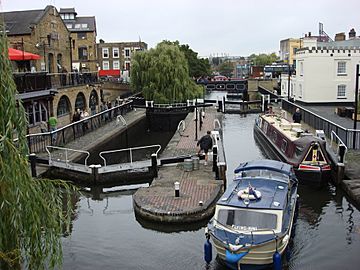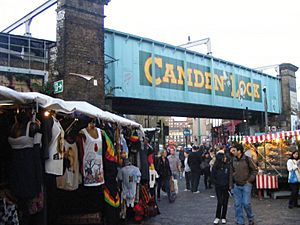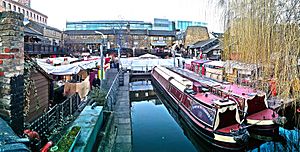Camden Lock facts for kids

The twin locks
|
|
| Waterway | Regent's Canal |
|---|---|
| County | Camden Greater London |
| Maintained by | Canal & River Trust |
| Operation | Manual |
| Fall | 8 feet (2.4 m) |
| Distance to Limehouse Basin |
6.17 miles (9.9 km) |
| Distance to Paddington Basin |
2.77 miles (4.5 km) |
| Coordinates | 51°32′28″N 0°08′45″W / 51.5411°N 0.1457°W |
Camden Lock is a well-known area in Camden Town, London. It used to be a busy dock with stables for horses on the Regent's Canal. Right next to it are the Hampstead Road Locks. These are a pair of locks, meaning there are two side-by-side. They are operated by hand. Together, they are called "Hampstead Road Lock 1." Other locks, like Hawley Lock and Kentish Town Lock, are nearby. To the west, the canal stretches for about 27 miles (43 km) before the next lock.
Contents
History of Camden Lock
The Regent's Canal was approved in 1812. It was planned to run from Paddington to Limehouse. The people in charge wanted to build all locks in pairs. This was to save water, as one lock emptying could help fill the other.
Early Ideas for Locks
An engineer named William Congreve suggested using special "boat lifts" instead of traditional locks. These lifts would use water and compressed air to move boats up and down. Similar ideas had been tried before but didn't work well. A company called Maudslay & Co built a test lift at Camden Town. However, it had many problems and never worked as planned. In 1818, the canal company decided to stick with traditional paired locks. The boat lift was sold off, and the idea was dropped.
Building the Locks and Canal
The canal's construction was overseen by architect John Nash. The Hampstead Road Locks were built between 1818 and 1820. They were made of brick with stone tops. The two locks sit side-by-side with a platform in the middle. Both locks are now Grade II listed, which means they are important historical structures. These were the first of 12 pairs of locks that lowered the canal's level by 96 feet (29 m) to reach Limehouse Basin.
Operating these paired locks was tricky. So, during the canal's busiest times, lock-keepers worked 24 hours a day. As canal use slowed down, fewer people were needed. Later, most paired locks were changed into single locks to make them easier for boat crews to use. Hampstead Road Lock is special because both chambers have been kept. In 2013, the locks were drained for maintenance, and people could even visit to see inside them!
The lock is located west of the Camden High Street road bridge. The original brick bridge was replaced by a stronger cast iron bridge in 1878. Near the lock, there's an old building from 1815. It was first used for air compressors for the failed boat lift. Later, it became the lock keeper's house and is now a coffee shop. To the west, there's an old cast iron bridge for people and horses to cross. Another bridge carries the towpath over an old dock entrance.
Camden Goods Depot
Camden Goods Depot was a big railway freight station in London. It was built so goods could be easily moved between trains and canal boats. This allowed freight to reach the London docks. The depot was finished in 1839. It had many buildings, including sheds for locomotives, ovens to make smokeless fuel, goods sheds, and stables for horses.
In 1841, a company called Pickfords built a warehouse on the canal's south bank. It was the first building in Britain where goods could be transferred between trains, roads, and canals. It was connected to the goods depot by a wooden railway bridge.
Later, the railway company built its own transfer facilities. They bought more land and built a new basin and dock. They also built two new engine sheds. One of these, called the Roundhouse, is still standing and is a very important historical building.
The goods depot was expanded several times to handle more traffic. It included more stables and tunnels for horses. The depot closed around 1980. Even though some buildings were removed, many parts of this old transport hub still exist. They show how important horses were in the early railway system.
Camden Lock Market
By the late 1960s, commercial traffic on the Regent's Canal had almost stopped. The area around Hampstead Road Locks became run down. Many factories had moved away. The land was unused, and the towpath needed repairs. There were also plans for a big motorway that would have covered much of the canal.
A company called Northside Developments bought the lease for a wharf near the lock in 1971. They wanted to create workshops where people could make and sell things. They also hoped to add a restaurant and a cinema. The local council had wanted to knock everything down, but Northside convinced them to save some of the old buildings.

With a small budget, Northside started turning the old buildings into craft workshops. No new buildings were put up because the area was still planned for demolition. By mid-1972, workshops were ready, and businesses started moving in. The official opening was on April 4, 1973. Soon after, the motorway plans were dropped.
The towpath was improved and opened to the public in 1972. A dance hall called Dingwall's Dance Hall opened in June 1973 in an old warehouse. It became famous for live music, especially punk rock bands.
In 1974, Northside got permission to run a Saturday antiques market. It started with 12 stalls and quickly grew to 30. Better access to the canal towpath was created. The towpath from London Zoo to Camden High Street was then opened for everyone to use.
The market was a big success. Within a year, it was allowed to open on Sundays and Bank Holidays too. Soon, there were two restaurants and many different goods for sale. By the early 1980s, the market had almost 200 stalls and attracted about 11,000 visitors every weekend. There were also 39 businesses in the craft workshops. The area became known as Camden Lock, and the access road was officially renamed Camden Lock Place. It became a popular place for events and festivals.
Camden Lock Mooring Point
 |
|
| Type | River bus services |
|---|---|
| Locale | Camden Town |
| Owner | Canal & River Trust |
| Operator | London Waterbus Company |
The London Waterbus Company runs boat trips from Camden Lock. These boats travel west around Regent's Park, stop at London Zoo, and end at Little Venice. Many of the boats used are historic vessels.
Towpath Route
The canal towpath is open for people to walk or cycle. It offers a direct path to Camden Lock from East London, Paddington, and West London.
Public Transport Links
The closest London Underground stations are Camden Town and Chalk Farm. Both are on the Northern line. The nearest London Overground station is Camden Road station.



